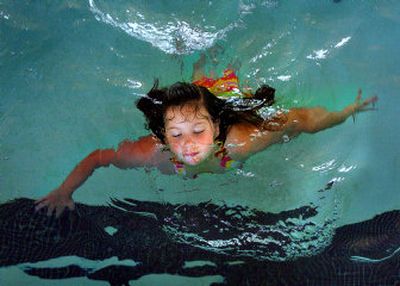Public swimming spots need a life preserver

The municipal pool in Davenport has been closed since 2002, emptied by a then-empty economy. Mary Hollis, Davenport’s finance manager, learned how to swim in the pool in the 1960s. People tell her now, “You have beautiful streets in Davenport, but that is a sad little spot.” Indeed.
Davenport, 35 miles west of Spokane, has 1,730 residents. It’s understandable why the town struggled to maintain a pool program that cost $30,000 a year. Town leaders are discussing ways to bring the pool back to life. Davenport’s pool woes might soon be Spokane’s.
This summer, Spokane residents need to figure out the future of swimming in Spokane. Why the urgency? For starters, this is the last season for Shadle’s indoor pool. No reprieves. Shadle is the only indoor municipal pool left in Spokane. And the city’s five outdoor pools – Witter, A.M. Cannon, Comstock, Liberty and Hillyard – are in need of major repairs.
Add to this the changing swimming habits of young people. They like water parks, filled with snaking slides and bucket-waterfalls. And finally, free swimming – a Spokane tradition – is expensive in tight budget times when police, fire, parks and libraries compete for limited dollars.
At Comstock Park on Thursday, I interviewed Liza Mattana and Mary Gaddy. They both served on the Aquatics Citizens Advisory Committee, which presented its pool ideas to the Spokane Park Board last year.
As we talked in the late afternoon sun, the South Side park’s pool came alive. Kids bobbed up and down in the water. The lifeguards, wearing bright red swimsuits, patrolled the pool. Summer was returning to Spokane.
The committee’s proposal includes an indoor aquatics facility, the closing of Comstock pool and the building of a new pool at Thornton Murphy Park, 27th Avenue and Ray Street, and the refurbishing of the city’s remaining pools. Fees would be charged at the indoor facility and at the new pool, but swimming would remain free everywhere else. The project’s total cost: $45 million.
Spokane City Councilman Al French has also proposed building an indoor aquatics and recreation center, under the auspices of a public development authority. An advisory group is now exploring the PDA concept.
Liza and Mary hope their committee’s plan, which preserves free swimming, becomes reality. Mary, who raised her nine children in Hillyard, said, “The poorest of the poor can swim here without having a dime.”
Liza, who grew up swimming at Comstock and swims there now with her 3-year-old daughter, said, “Swimming teaches children independence. It improves their health.”
Both women pointed out that Spokane Parks Department swim lessons help children more safely venture into nearby lakes and rivers. And pool programs spawn our future lifeguards and swimming champs.
To explore how other towns are keeping pools vital for their children, I plan to swim in every municipal pool within 90 minutes of Spokane – both in North Idaho and Washington. If you have a town-supported pool in your community, invite me for a dip.
That’s my summer assignment. Now here’s an assignment for city of Spokane residents: Visit a city pool. You will soon be asked to decide the future of swimming here – and help pay for it. Don’t be afraid to jump in.